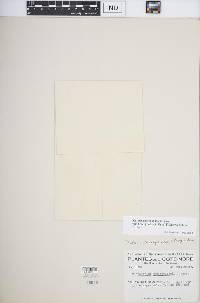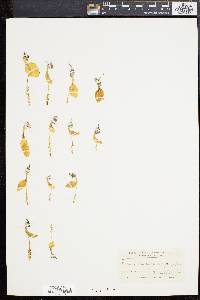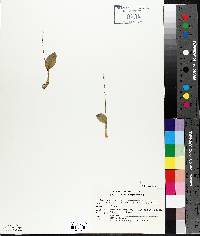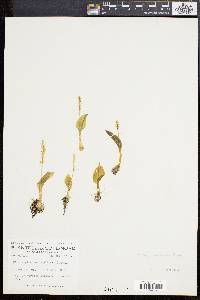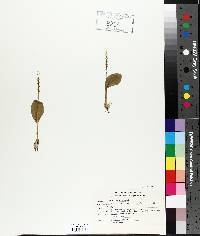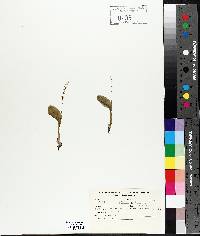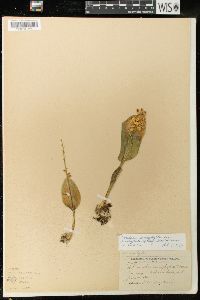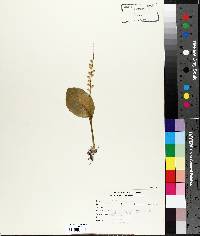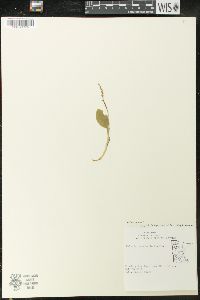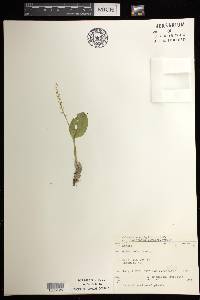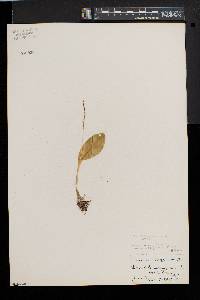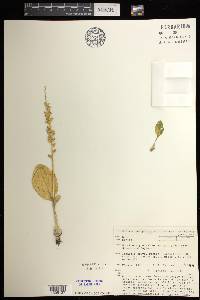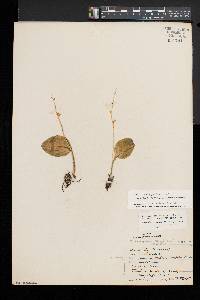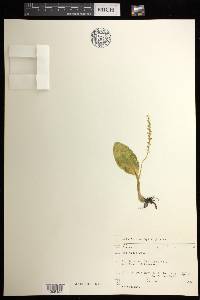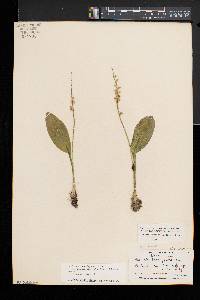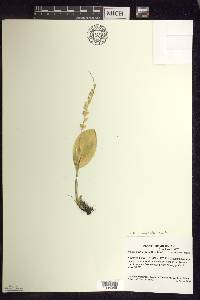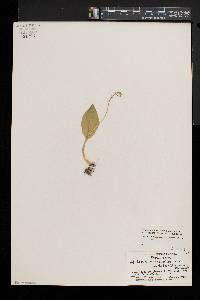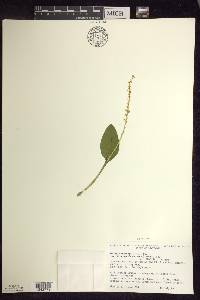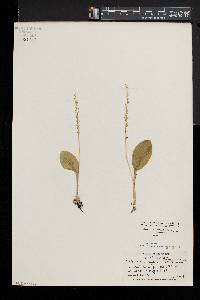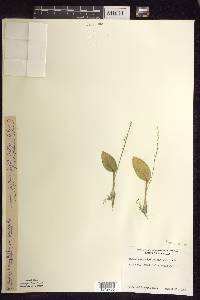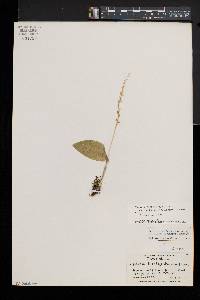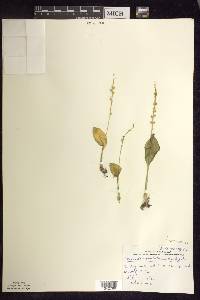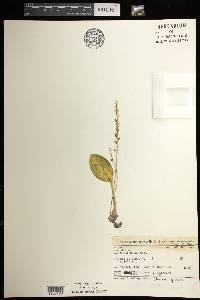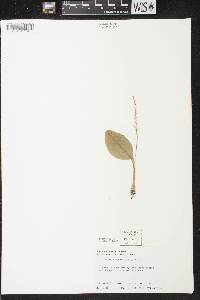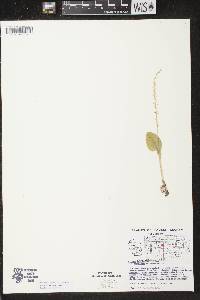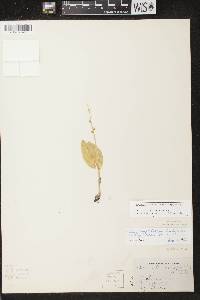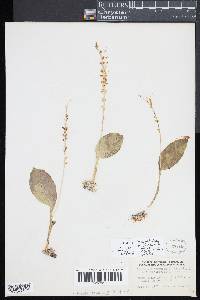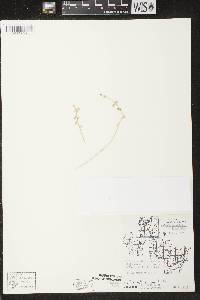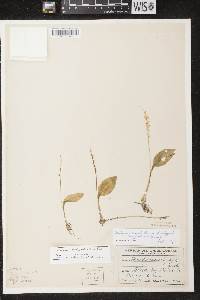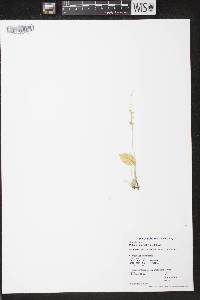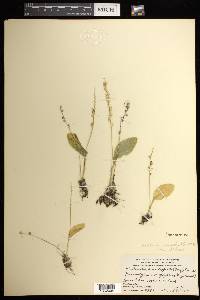Malaxis monophyllos var. brachypoda
|
|
|
|
Family: Orchidaceae
White Adder's-Mouth Orchid
[Microstylis brachypoda A.Gray] |
Plants 3-30 cm. Pseudobulbs 4-8 mm diam. Leaves 1(-2, rarely), petiolate base sheathing stem; blade light green, ovate-elliptic, keeled abaxially, 1.5-9.5 × 1-5 cm, apex acute. Inflorescences: floral bracts lanceolate, 1.5-2 mm; pedicels 2-4.5 mm. Flowers resupinate, green or greenish white; dorsal sepal ovate-lanceolate, 1.5-2.5 × 1-1.4 mm, margins revolute, apex acuminate; lateral sepals oblong-lanceolate, slightly falcate, 1.5-2.5 × 0.5-1.2 mm, apex acuminate; petals strongly reflexed, filiform to narrowly linear-lanceolate, 1.4-2.5 × 0.3-0.4 (-0.5) mm, apex rounded; lip broadly triangular, concave, 3-lobed, middle lobe ovate, apex acuminate, lateral lobes auriculate, thickened, curved upward; disc with 2 low, thickened, elongate calli, 1.3-2.2 × 1.2-1.8(-2) mm; column 0.4-0.6 × 0.4-0.6 mm. 2n = 28. Flowering summer. Swamps, bogs; 0--400 m; Alta., B.C., Man., N.B., Nfld. and Labr., N.S., Ont., P.E.I., Que., Sask., Yukon; Alaska, Calif., Colo., Ill., Ind., Maine, Mass., Minn., N.H., N.Y., Pa., Vt., Wis. Perennial herb 3 - 30 cm tall Stem: one, erect, pale green, glossy, hairless, averaging 5 - 15 cm tall. Inflorescence: a single, erect, terminal, long-stalked, slender, loose, spike-like cluster of five to eighty, short-stalked flowers. Each 2 - 4.5 mm long flower stalk is subtended by a single, tiny (1 - 2 mm long), lance-shaped bract. Flowers: green or greenish white, small, bilaterally symmetric, open (sepals spreading), with lowest petal formed into a three-lobed lip, but lacking a spur. The reproductive parts of stamens, stigma and style are fused into a short (0.4 - 0.6 mm long and wide) column above the inferior ovary. Sepals: three, spreading, greenish white, short (1.5 - 2.5 mm), narrow (0.5 - 1.4 mm), linear-oblong to lance-shaped with narrowed pointed tips, and rolled edges. Fruit: several, short-stalked, ascending, ellipsoid, 0.5 cm long, 3 mm wide capsules. Root system: of a 4 - 8 mm diameter egg-shaped pseudobulb anchored on substrate. Leaf: one, ascending, stalked, sheathing to middle of stem, light green, non-toothed, hairless, 1.5 - 9.5 cm long, 1 - 5 cm wide, elliptic to egg-shaped, tapering to pointed tip, and lengthwise ridge (keel) along lower surface. The leaf stalk clasps the stem for at least half the stem length, then expands into the broad blade, however sometimes in very young flowering plants the blade is more linear. Lateral petals: two, strongly reflexed, greenish white, 1.4 - 2.5 mm long, 0.3 - 0.5 mm wide, threadlike or narrowly linear-lance-shaped. Lip petal: one, central, lowermost, greenish white, 2 - 2.5 mm long, 1 - 2 mm wide, broadly triangular but three-lobed with two lateral lobes small, ear-shaped, rough, thickened, and curved inward and upwards. The conspicuous central lobe is largest, egg-shaped with a distinctly pointed tip, and the central area of the upper surface has two low, thickened elongate ridges about 1.3 - 2.2 mm long and 1.2 - 2 mm wide. Similar species: Malaxis monophyllos var. brachypoda is most similar to M. unifolia , but that species has flowers in a dense somewhat flat-topped inflorescence (older flower stalks elongate placing flowers close to younger blooms and buds), the flower stalks are longer (up to 1 cm), and the lip is three-toothed at the apex with the central tooth very short and indistinct so the lip appears only to be two-lobed. Flowering: mid-June to August Habitat and ecology: Extremely rare, mainly in cold wet soils with neutral pH, usually shaded and often hidden among moss or sedges in swamps and bogs. A much more northern species with very spotty distribution in the Chicago Region, one of the few confirmed collections was from a hanging fen in Elgin, Kane County, Illinois. Occurence in the Chicago region: native Notes: The typical variety, Malaxis monophyllos var. monophyllos, only occurs in the extreme northwest of North America in Alaska and on the Queen Charlotte Islands of British Columbia. It differs from our variety by having flowers with the lip petal on top and the lateral petals below. Etymology: Malaxis is Greek for softening, in reference to the soft pliable leaves of the genus. Monophyllos means one leaf, referring to the single leaf in this plant. Brachypoda means short-stalked, in reference to the very short flower stalks of this variety. Author: The Field Museum From Flora of Indiana (1940) by Charles C. Deam ...... Indiana Coefficient of Conservatism: C = 10 Wetland Indicator Status: FACW |



